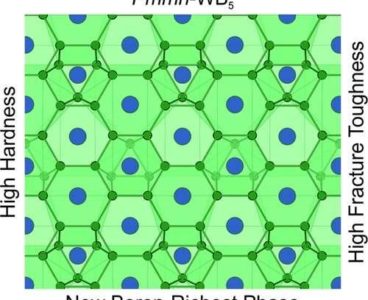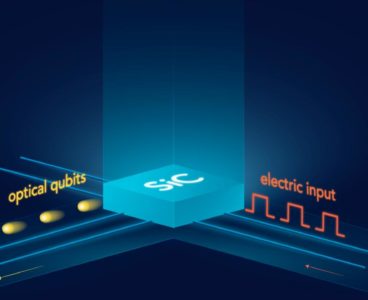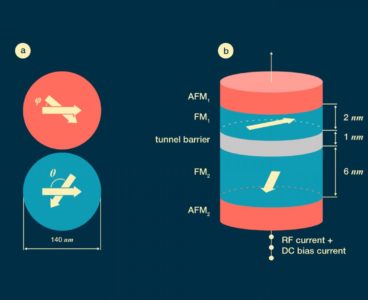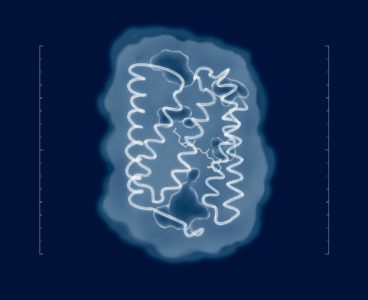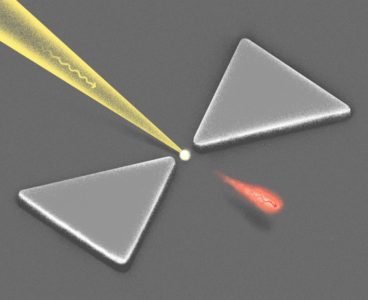Researchers from the Moscow Institute of Physics and Technology and their colleagues from Germany and the Netherlands have achieved material magnetization switching on the shortest timescales, at a minimal energy cost. They have thus developed a prototype of energy-efficient data storage devices. The paper was published in the journal Nature. The rapid development of information…
Semiconductor Scientists Uncover ‘Impossible’ Effect
A physical effect known as superinjection underlies modern light-emitting diodes (LEDs) and lasers. For decades this effect was believed to occur only in semiconductor heterostructures—that is, structures composed of two or more semiconductor materials. Researchers from the Moscow Institute of Physics and Technology have found superinjection to be possible in homostructures, which are made of…
Physicists Reverse Time Using Quantum Computer
Researchers from the Moscow Institute of Physics and Technology teamed up with colleagues from the U.S. and Switzerland and returned the state of a quantum computer a fraction of a second into the past. They also calculated the probability that an electron in empty interstellar space will spontaneously travel back into its recent past. The study comes…
Physicists Reach Breakthrough in Nanolaser Design
Nanolasers have recently emerged as a new class of light sources that have a size of only a few millionths of a meter and unique properties remarkably different from those of macroscopic lasers. However, it is almost impossible to determine at what current the output radiation of the nanolaser becomes coherent, while for practical applications,…
Scientists Uncover Nanoparticles with Unique Chemical Composition
Scientists from Russia and China discovered a host of new and unexpected nanoparticles and found a way to control their composition and properties — the findings break fresh ground in the use of nanoparticles. The results of their study were published in Physical Chemistry Chemical Physics. Micro objects such as nanoparticles can differ from macro…
Physicists Edge Closer to Controlling Chemical Reactions
A team of researchers from the Moscow Institute of Physics and Technology, and Aarhus University in Denmark has developed an algorithm for predicting the effect of an external electromagnetic field on the state of complex molecules. The algorithm, which is based on a theory developed earlier by the same team, predicts tunneling ionization rates of…
Nature-Inspired Crystal Structure Predictor
Scientists from Russia found a way of improving the crystal structure prediction algorithms, making the discovery of new compounds multiple times faster. The results of the study were published in Computer Physics Communications. Given the ever increasing need for new technologies, chemists should constantly discover new higher-performance materials with better strength, weight, stability and other…
Sensor Decodes Brain Activity
Researchers from the Moscow Institute of Physics and Technology have developed a model for predicting hand movement trajectories based on cortical activity: Signals are measured directly from a human brain. The predictions rely on linear models. This offloads the processor, since it requires less memory and fewer computations in comparison with neural networks. As a…
Researchers Upgrade Organic Solar Cells to be Used in Roof Tiles Generating Power
An international team of materials scientists from France, Russia and Kazakhstan found a way to boost the efficiency of organic solar cells several times. The new study, published in the Journal of Materials Chemistry A, has shown that ordered structures based on organic molecules can be used to produce solar power. Solar panels, or batteries, are…
Mystery of Vanishing Graphene Particles Solved
Researchers from the Moscow Institute of Physics and Technology and Tohoku University have explained the puzzling phenomenon of particle-antiparticle annihilation in graphene, recognized by specialists as Auger recombination. Although persistently observed in experiments, it was for a long time thought to be prohibited by the fundamental physical laws of energy and momentum conservation. The theoretical…
Scientists Predict a New Superhard Material With Unique Properties
Chemists from Russia and China have predicted a new superhard material that can be used in drilling, machine building and other fields. The new tungsten boride they discovered outperforms the widely used ‘pobedit’ ? a hard tungsten carbide and cobalt composite material with artificial diamond interspersing. The results of their study were published in the…
Innovative Biosensor Chips Based on Copper and Graphene Oxide
Russian researchers from the Moscow Institute of Physics and Technology have developed biosensor chips of unprecedented sensitivity, which are based on copper instead of the conventionally used gold. Besides making the device somewhat cheaper, this innovation will facilitate the manufacturing process. The research findings are reported in the journal Langmuir, named in honor of Irving…
World’s First Biosensor Chips Based on Copper and Graphene Oxide
Russian researchers from the Moscow Institute of Physics and Technology have developed biosensor chips of unprecedented sensitivity, which are based on copper instead of the conventionally used gold. Besides making the device somewhat cheaper, this innovation will facilitate the manufacturing process. The research findings are reported in the journal Langmuir, named in honor of Irving Langmuir…
Scientists Discover a Link Between Superconductivity and the Periodic Table
Scientists from Moscow Institute of Physics and Technology and Skoltech have demonstrated the high-temperature superconductivity of actinium hydrides and discovered a general principle for calculating the superconductivity of hydrides based on the periodic table alone. The results of their study were published in The Journal of Physical Chemistry Letters. High-temperature superconductivity is a phenomenon of zero…
Scientists Elucidate the Crystal Structure of Sodium Boride
An international team of scientists jointly with Professor Artem Oganov of Skoltech and the Moscow Institute of Physics and Technology worked out the chemical composition, crystal structure, and properties of Na2B30 — a compound that remains stable at standard conditions and has long been the subject of heated debate. The results of the study were…
Physicists Reveal Material for High-Speed Quantum Internet
The race for quantum computing is on: Industry giants, such as Google, IBM, and Microsoft, and leading international research centers and universities are involved in the global effort to build a quantum computer. It is not known yet when this new technology can become a reality, but the world is getting ready. The greatest expectation…
MIPT Physicists Tune a Spin Diode
A team of physicists at MIPT has offered a new design of a spin diode, placing the device between two kinds of antiferromagnetic materials. By adjusting the orientation of their antiferromagnetic axes, it is possible to change the resistance and the resonant frequency of the diode. In addition, this approach triples the range of frequencies…
Mathematicians Crack 44-Year-Old Problem
Structure of Primary Optogenetic Tool Revealed
An international team of researchers from the Moscow Institute of Physics and Technology, Forschungszentrum Jülich, the European Synchrotron Radiation Facility, the Institut de Biologie Structurale, and the Max Planck Institute of Biophysics has determined the 3-D structure of channelrhodopsin 2, a membrane protein widely used in optogenetics to control nerve cells with light. Optogenetics is…
Physicists Explain Metallic Conductivity of Thin Carbon Nanotube Films
An international team of researchers from MIPT; Lebedev Physical Institute, RAS; Prokhorov General Physics Institute, RAS; Skoltech; and Aalto University (Finland) has examined the optical and dielectric properties of thin macroscopic films based on single-walled carbon nanotubes and obtained an explanation for the metallic nature of their conductivity using infrared and terahertz spectroscopy. The research…
Novel Room-Temperate Gas Detection Method Developed
Russian researchers have developed a mechanism for detecting molecular hydrogen using green light to illuminate a nanocrystalline composite sensor based on zinc and indium oxides. For the first time, this enables a gas sensor operating at room temperature. The paper was published in the journal Scientific Reports. Multisensor arrays for determining gas mixture composition are…
Scientist Finds a New Way to Predict Cancer Development
A scientist from the Moscow Institute of Physics and Technology (MIPT) has proposed a model that can predict the number of key carcinogenic events for each cancer type based on the relationship between morbidity and age. The results of his study were published in the prestigious journal Scientific Reports. The progression from one carcinogenesis stage to…
Physicists Predict Nonmetallic Half-Metallicity
A team of researchers from the Moscow Institute of Physics and Technology (MIPT) and the Institute for Theoretical and Applied Electrodynamics (ITAE) of the Russian Academy of Sciences (RAS), in collaboration with a colleague from RIKEN (Institute for Physical and Chemical Research in Japan), has provided theoretical proof of the existence of a new class…
Scientists Announce the Quest for High-index Materials for Optical Nanoantennas
An antenna is a device capable of effectively transmitting, picking up, and redirecting electromagnetic radiation. Typically, antennas are macroscopic devices operating in the radio and microwave range. However, there are similar optical devices (Fig. 1). The wavelengths of visible light amount to several hundred nanometers. As a consequence, optical antennas are, by necessity, nanosized devices.…
How Fullerite Becomes Harder than Diamond
Physicists have simulated the structure of a new material based on fullerite and single crystal diamond to show how this material can obtain ultrahigh hardness. This discovery allows the estimations the potential conditions for obtaining ultrahard materials. The results were published in the Carbon journal. Fullerite generally is a molecular crystal with fullerene molecules at its lattice…





